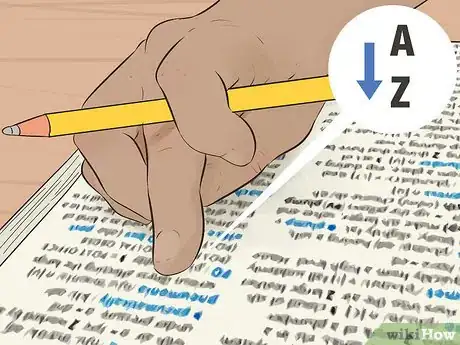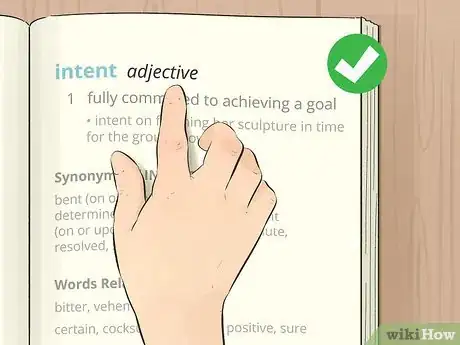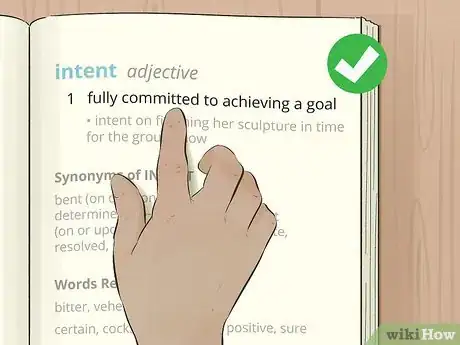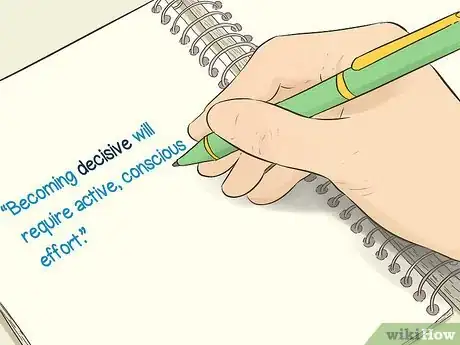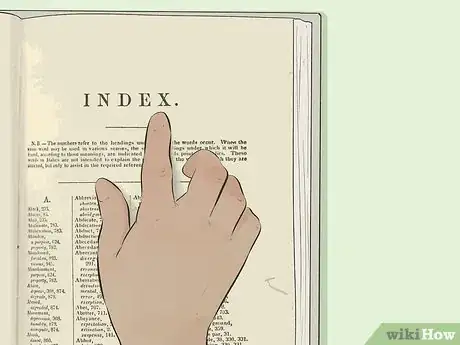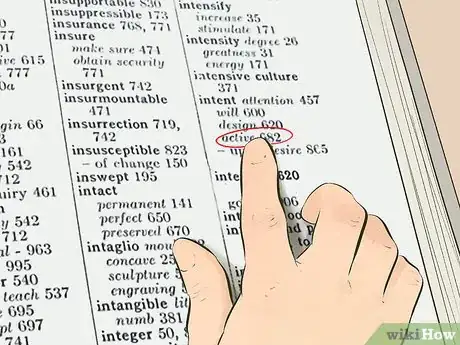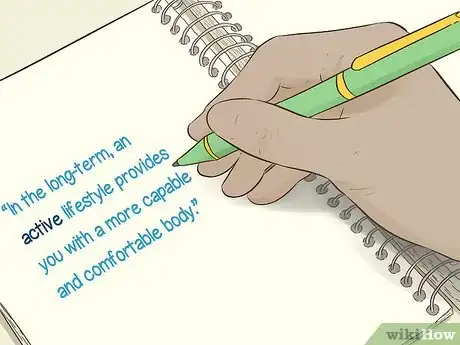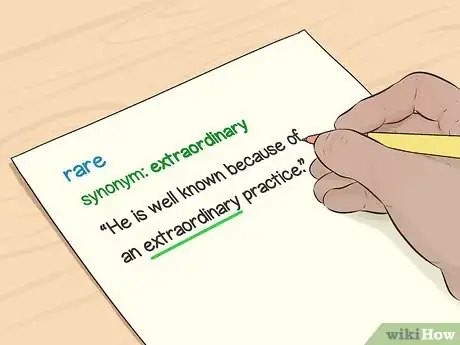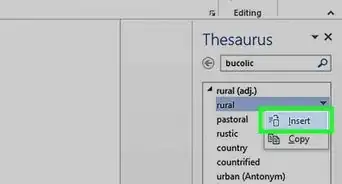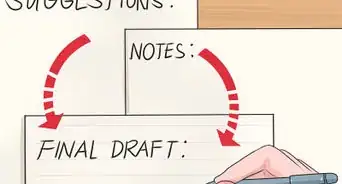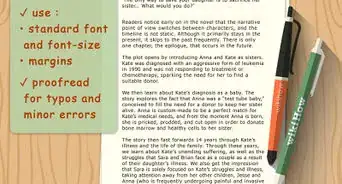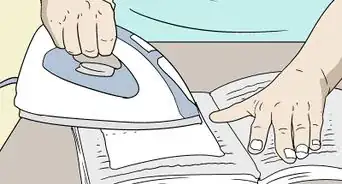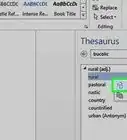This article was co-authored by wikiHow Staff. Our trained team of editors and researchers validate articles for accuracy and comprehensiveness. wikiHow's Content Management Team carefully monitors the work from our editorial staff to ensure that each article is backed by trusted research and meets our high quality standards.
This article has been viewed 104,965 times.
Learn more...
A thesaurus is a great tool if you feel as though your writing is repetitive or you simply can’t find the right word to say what you want to say. In order to avoid common mistakes, use the correct style of thesaurus for your needs, understand each part of the thesaurus entry and stay true to your original context. With proper use, a thesaurus can add variety and power to your writing.[1]
Steps
Searching for Synonyms in an Alphabetical Thesaurus
-
1Look up the word you’re interested in alphabetically in the main body of the book. Make sure you’re spelling the word correctly and proceed to that listing. Some terms (in the photo, the ones in SMALL CAPS) may be cross references. Looking up cross references can help you better understand the meaning of the word you've looked up.[2]
- Homonyms are words that sound the same, but have different meanings. Check the word’s spelling and its contextual use in a dictionary to be sure you haven’t used the incorrect word.
-
2Use the italicized term next to your chosen word to determine what grammatical category it falls into. This will tell you if the word is a noun, adjective or verb and will make sure you’re using the synonym correctly. For example, if your original word was a verb, make sure the synonym you’re using is also a verb.
- This will also tell you if you’re using similar word the right way. For example, “intent” can be an adjective or a noun. However, “intention” is also a noun with the same meaning.
Advertisement -
3Look directly beneath the word to find the definition of your original word. This will help you understand if your original word didn’t quite mean what you wanted or if it has an entirely different meaning. Your thesaurus will include a definition of your original word to help you understand if a synonym is appropriate or if you want to consider a different word completely.
- If your thesaurus doesn’t include definitions, look the word up in a dictionary to be sure of its meaning.
-
4Select the synonym you will use. When you go to the alphabetical listing of the word you’ve looked up, you’ll see a list of other words that have similar meanings. Choosing the correct word will depend on the context of your sentence and your intent. Use your dictionary to check the meaning of any word that interests you. Look up how it can be used in a sentence and see if your original meaning still makes sense.[3]
- Some words or phrases may be idioms. Make sure to check for any cultural context that could change the word’s meaning.
- If you’re using an historical dictionary, it will also include words that were appropriate for certain time periods. Make sure the word you select is also relevant to the contemporary context of what you’re writing.[4]
-
5Use the synonym in your original sentence. Return to your original text and see if the word fits with your original intent. Use it in a sentence to make sure the new word matches your tone and voice. Check to see if any surrounding verbs, nouns or adjectives need to be changed or removed if the new synonym has clarified your point. You shouldn’t use a thesaurus to simply add additional words to your text, they should be necessary to the text.[5]
- If you’re still unsure if the synonym you’ve chosen is correct, look it up in a dictionary. Check out other synonyms listed in your thesaurus and see if they might be a better fit.
Searching for Synonyms in a Roget-Type Thesaurus
-
1Understand how your thesaurus is organized. Some traditional thesauri are organized by an index in the back of the book. This index will send you to a longer, numbered entry. Others are organized by general categories. Your thesaurus will have a guide that explains how it should be used. Read it thoroughly.[6]
- Traditional thesauruses also offer antonyms.
-
2Use the alphabetical index at the back of the thesaurus to find your word. That will lead you to a number that leads to an entry for the original word you’d like to look up. This index allows for longer, more detailed entries. Use your dictionary to be sure you’re spelling the word correctly.
- Homonyms are words that sound the same, but have different meanings. Check the word’s spelling and its contextual use in a dictionary to be sure you haven’t used the incorrect word.
- Rather than list a small selection of synonyms for each term like an alphabetical thesaurus (which can lead to duplication) there is an index to longer, numbered entries. All the words in the entry will appear in the index just once.
-
3Select the synonym you will use. When you go to the alphabetical listing of the word you’ve looked up, you’ll see a list of other words that have similar meanings. Choosing the correct word will depend on the context of your sentence and your intent. Use your dictionary to check the meaning of any word that interests you. Look up how it can be used in a sentence and see if your original meaning still makes sense.[7]
- Some words or phrases may be idioms. Make sure to check for any cultural context that could change the word’s meaning.
-
4Use the synonym in your original sentence. Return to your original text and see if the word fits with your original intent. Use it in a sentence to make sure the new word matches your tone and voice. Check to see if any surrounding verbs, nouns or adjectives need to be changed or removed if the new synonym has clarified your point. You shouldn’t use a thesaurus to simply add additional words to your text, they should be necessary to the text.[8]
- If you’re still unsure if the synonym you’ve chosen is correct, look it up in a dictionary. Check out other synonyms listed in your thesaurus and see if they might be a better fit.
Choosing the Appropriate Word for Your Needs
-
1Look up your original word and the word you’ve chosen in a dictionary. Be sure you understand what both words mean. Some words may seem similar but might not apply in your particular context. For example, you wouldn’t want to use “bloodless” if you’re describing something that’s “pale.”[9]
- Some thesauri list idioms, these are cultural phrases whose meaning relies on cultural context. Make sure you research any possible idioms you could be using and if they make sense in context.
- If you’re using an historical thesaurus, it will provide synonyms from different time periods. Make sure the word you select is correct for the time period you’re writing about.[10]
-
2Use a thesaurus sparingly. Synonyms can be a great way to improve your writing, but be sure you don’t lose your meaning and voice by relying too much on a thesaurus. There’s no need to replace every word in a paragraph with a synonym, so start with any words that seem out of place in your writing.[11]
- Over use of a thesaurus can be a distraction[12]
-
3Use the synonym in your original sentence. Return to your original text and see if the word fits with your original intent. Use it in a sentence to make sure the new word matches your tone and voice. Check to see if any surrounding verbs, nouns or adjectives need to be changed or removed if the new synonym has clarified your point.[13]
- Don't be afraid to try a few synonyms to find the best fit for your voice.
Community Q&A
-
QuestionDoes a thesaurus provide antonyms?
 DonaganTop AnswererYes.
DonaganTop AnswererYes. -
QuestionIf it has 2 answers, which one do I use?
 DonaganTop AnswererLook up each synonym in a dictionary, and decide which word best fits your needs.
DonaganTop AnswererLook up each synonym in a dictionary, and decide which word best fits your needs. -
QuestionCould you use a thesaurus to find a connotation of a word?
 DonaganTop AnswererPossibly, but a dictionary would be better.
DonaganTop AnswererPossibly, but a dictionary would be better.
Warnings
- Always use a dictionary to make sure the synonym you want to use is correct. You’ll want to make sure the word applies to your context.⧼thumbs_response⧽
- Use a thesaurus sparingly! You don’t want to lose your meaning or voice.⧼thumbs_response⧽
References
- ↑ https://www.writing-skills.com/when-should-you-use-a-thesaurus
- ↑ http://www.slcc.edu/cwc/docs/resources/how-to-use-a-thesaurus.pdf
- ↑ https://www.bartleby.com/110/5000.html
- ↑ https://public.oed.com/how-to-use-the-historical-thesaurus-of-the-oed/#synonyms
- ↑ https://public.oed.com/how-to-use-the-historical-thesaurus-of-the-oed/#synonyms
- ↑ https://www.bartleby.com/110/5000.html
- ↑ https://www.bartleby.com/110/5000.html
- ↑ https://public.oed.com/how-to-use-the-historical-thesaurus-of-the-oed/#synonyms
- ↑ https://www.writing-skills.com/when-should-you-use-a-thesaurus
